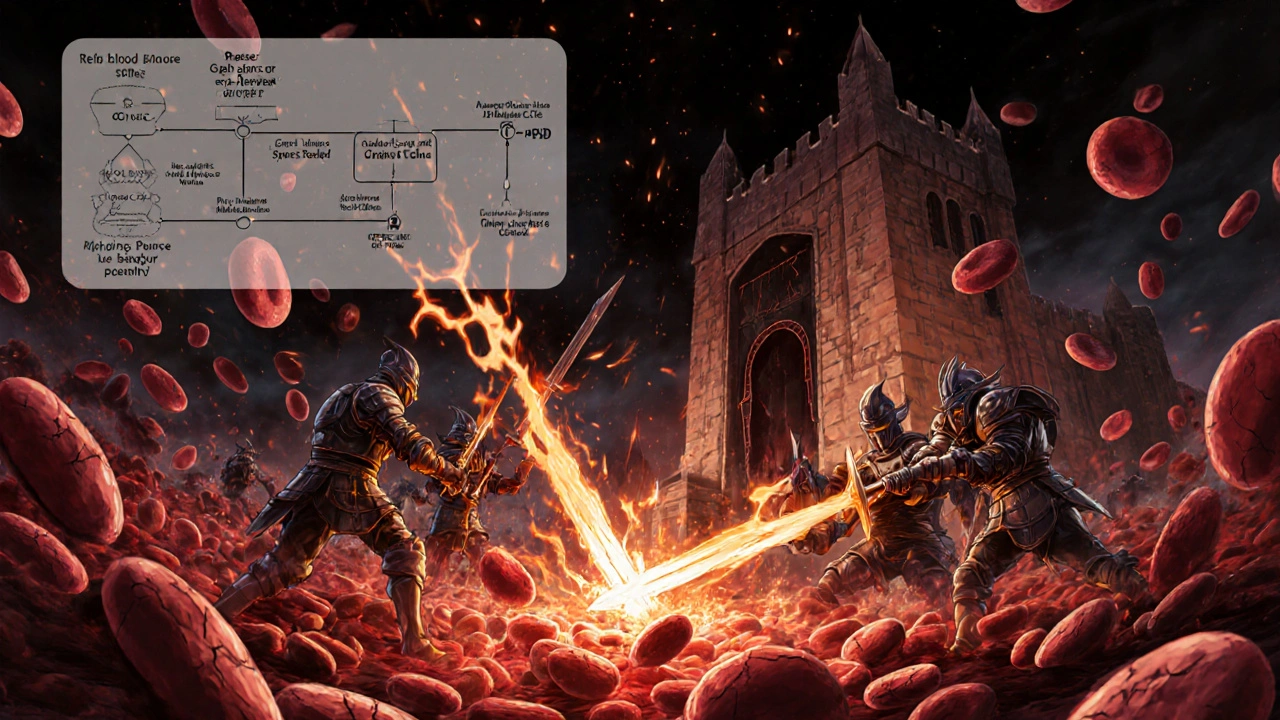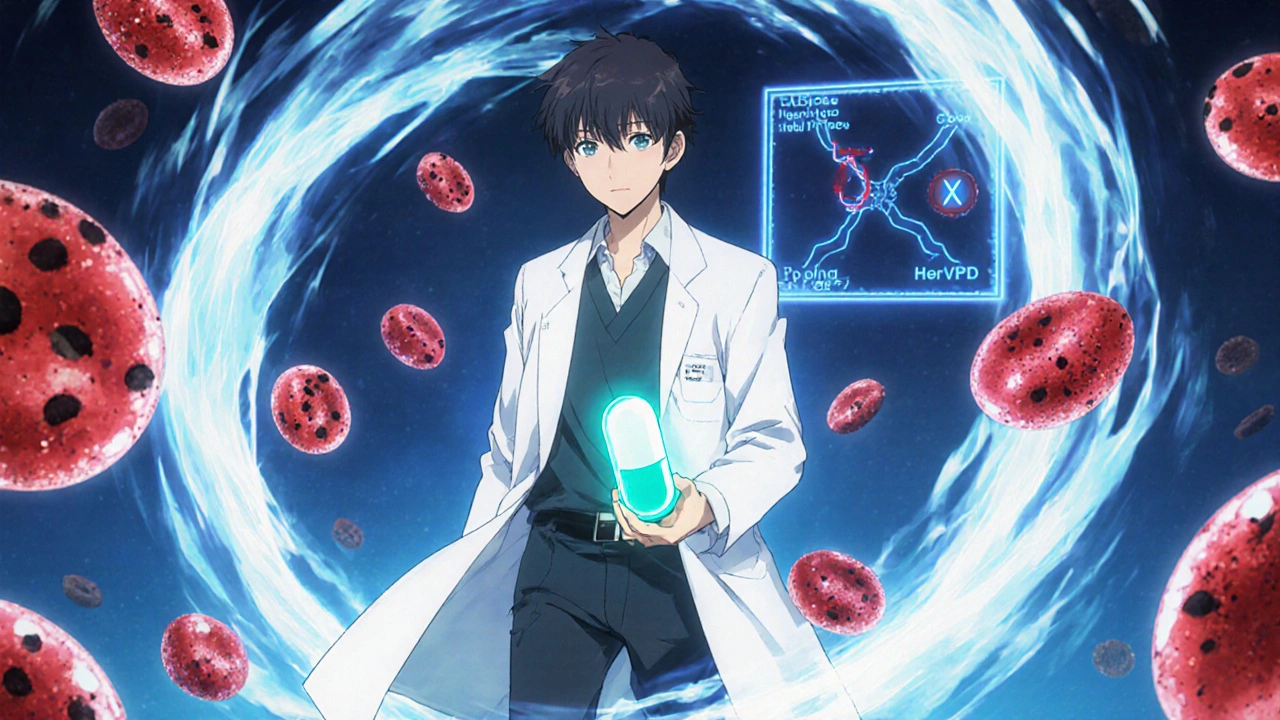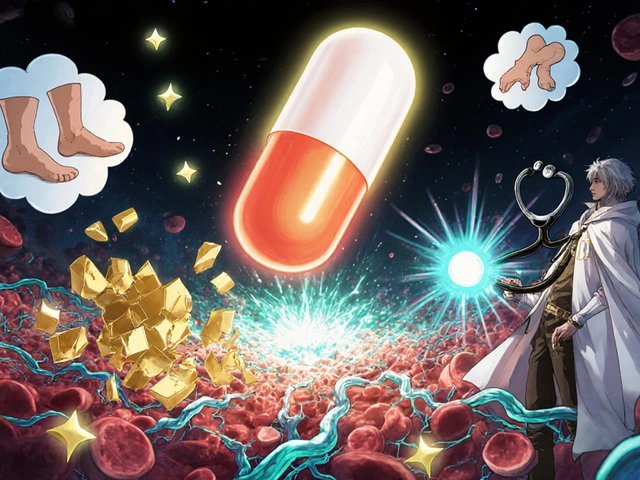G6PD Deficiency & Nitrofurantoin Risk Calculator
This tool calculates the risk of hemolytic anemia in patients considering nitrofurantoin therapy based on key clinical factors. Nitrofurantoin can cause acute hemolytic anemia in people with G6PD deficiency, especially within the first 72 hours of therapy.
Risk Assessment Form
Key Takeaways
- nitrofurantoin can cause acute hemolytic anemia in people with G6PD deficiency.
- Risk is highest during the first 72 hours of therapy and in populations with a high prevalence of G6PD deficiency.
- Guidelines (CPIC, American Society of Hematology) recommend avoiding nitrofurantoin in confirmed G6PD‑deficient patients, especially those with chronic non‑spherocytic hemolytic anemia.
- Screening before prescription is cost‑effective in high‑risk groups and can prevent costly hospitalizations.
- Safer alternatives such as fosfomycin or trimethoprim‑sulfamethoxazole should be considered when G6PD status is unknown.
What Is Nitrofurantoin?
nitrofurantoin is a synthetic antibacterial agent first introduced in the 1940s and marketed under brand names like Furadantin and Macrobid. It is primarily used for treating uncomplicated urinary tract infections (UTIs) because it concentrates in urine and maintains activity in an acidic environment.
The drug works by being reduced by bacterial flavoproteins into reactive intermediates that damage bacterial ribosomal proteins, DNA, and metabolic enzymes, halting bacterial growth. Its narrow spectrum and low resistance rates (about 10‑15 % in Escherichia coli) have kept it a first‑line choice for many clinicians.
How Nitrofurantoin Can Trigger Hemolysis
While the antibacterial effect relies on oxidative chemistry, the same oxidative stress can overwhelm red blood cells that lack sufficient protective mechanisms. In people with normal glucose‑6‑phosphate dehydrogenase (G6PD) activity, the pentose‑phosphate pathway continuously generates reduced glutathione, which neutralizes the drug‑derived reactive oxygen species.
In G6PD‑deficient individuals, the pathway is impaired. When nitrofurantoin is administered, oxidative intermediates accumulate, leading to:
- Oxidation of hemoglobin, forming Heinz bodies.
- Membrane damage and loss of deformability.
- Premature removal of red cells by the spleen - the clinical picture of acute hemolytic anemia.
Laboratory findings typically include a rapid drop in hemoglobin, elevated lactate dehydrogenase (LDH), indirect bilirubin, reticulocytosis, and low haptoglobin.
G6PD Deficiency Overview
G6PD deficiency is an X‑linked enzymatic disorder that affects roughly 400 million people worldwide, according to the World Health Organization. The condition is most prevalent in people of African, Mediterranean, Middle Eastern, and Southeast Asian ancestry, with prevalence rates ranging from 2 % to 14 % depending on the region.
Individuals with severe enzyme deficiency are prone to oxidative hemolysis when exposed to certain medications, foods, or infections. The clinical spectrum includes:
- Classic acute hemolytic episodes triggered by drugs like primaquine, sulfonamides, and nitrofurantoin.
- Chronic non‑spherocytic hemolytic anemia (CNSHA) in a minority of patients.
- Asymptomatic carriers who only manifest symptoms after a strong oxidative challenge.

Clinical Evidence Linking Nitrofurantoin to Hemolytic Anemia
The first published case of nitrofurantoin‑induced hemolysis appeared in a 1956 JAMA report describing a 28‑year‑old male who developed severe anemia within days of therapy. Since then, large‑scale pharmacovigilance analyses have documented 318 episodes of drug‑induced hemolysis, with 42 cases (≈13 %) directly linked to G6PD deficiency.
Key observations from recent studies (Recht et al., 2022; Bhatt, 2023) include:
- Median onset of symptoms: 24‑72 hours after the first dose.
- Peak hemoglobin nadir reached by day 3‑5.
- Hospitalization cost per episode: $8,500‑$12,000 (HCUP 2022).
- Fatalities: 10 reported deaths, all associated with delayed recognition.
High‑risk subgroups identified in case series are pregnant women (8 reported cases) and infants exposed via maternal therapy or overdose.
Risk Assessment: Who Is Most Vulnerable?
Combining epidemiologic data with drug exposure rates yields a rough estimate: with 5.5 million nitrofurantoin prescriptions annually in the United States and a 4 % G6PD deficiency prevalence in the general population, up to 220 000 individuals could be at risk each year.
Risk is amplified when the following conditions coexist:
- Known G6PD deficiency with CNSHA - CPIC advises absolute avoidance.
- Renal impairment (eGFR < 60 mL/min/1.73 m²) - reduced drug clearance may increase systemic exposure.
- Concurrent oxidative stressors such as infection or other hemolytic drugs.
- Pregnancy - altered red‑cell metabolism and increased renal excretion can modify drug dynamics.
Practical Guidance for Clinicians
Given the clear mechanistic link and documented cases, most professional societies now recommend a proactive approach:
- Screen for G6PD deficiency before prescribing nitrofurantoin to patients with any of the following:
- African, Mediterranean, or Southeast Asian ancestry.
- History of hemolytic episodes after medication or infection.
- Family history of G6PD deficiency.
- If the test is unavailable and the patient belongs to a high‑prevalence group, consider an alternative antibiotic.
- For patients with confirmed deficiency but no CNSHA, the CPIC suggests "caution" - use the lowest effective dose for the shortest duration, and monitor labs (CBC, LDH, bilirubin) within 48‑72 hours.
- In any patient who develops sudden fatigue, dark urine, jaundice, or a rapid hemoglobin drop after starting nitrofurantoin, discontinue the drug immediately and provide supportive care (IV fluids, possible transfusion).
- Document the adverse reaction in the electronic health record and flag the patient for future drug‑interaction alerts.
Cost considerations: a point‑of‑care G6PD test costs $35‑$50, while an average hemolysis hospitalization exceeds $9,000. Many health systems find pre‑emptive testing cost‑effective when the prevalence exceeds 5 %.

Comparison of Nitrofurantoin with Alternative UTI Agents in G6PD‑Deficient Patients
| Antibiotic | Primary Indication | Resistance in E. coli | G6PD‑Related Hemolysis Risk | Typical Use in G6PD‑Deficient Patients |
|---|---|---|---|---|
| nitrofurantoin | Uncomplicated UTI | 10‑15 % | High (oxidative) | Avoid if deficiency known; screen if unknown |
| fosfomycin (single‑dose) | Uncomplicated UTI | 5‑8 % | None reported | First‑line alternative |
| trimethoprim‑sulfamethoxazole (TMP‑SMX) | UTI, Pneumocystis prophylaxis | 20‑25 % | Low (sulfonamide‑related, but rare) | Use with caution; monitor for sulfa allergy |
| fluoroquinolones (ciprofloxacin) | Complicated UTI | ≈12 % | None reported | Reserve for resistant organisms |
The table shows that fosfomycin offers comparable efficacy without the oxidative hemolysis risk, making it the preferred option when G6PD status is uncertain.
Emerging Trends & Future Directions
Pharmacogenomic stewardship is gaining traction. The 2023 CPIC update introduces a risk‑stratified algorithm that categorizes G6PD variants into "severe" and "moderate" groups, guiding dose adjustments rather than blanket avoidance.
Point‑of‑care G6PD testing devices are being piloted in primary‑care clinics, delivering results in <10 minutes. Early economic models suggest that universal screening before any nitrofurantoin prescription could cut hemolysis‑related admissions by up to 70 %.
Large‑scale research networks such as the NIH Pharmacogenomics Research Network are running a multi‑center trial (NCT04567891) to validate cost‑effectiveness. Preliminary data released in Q2 2024 indicate a net saving of $1,200 per screened patient in high‑prevalence settings.
Regulatory bodies continue to update safety labeling. The European Medicines Agency added a prominent G6PD warning in 2021, while the US FDA has not yet required mandatory screening but accepts label changes based on new evidence.
Frequently Asked Questions
Can I take nitrofurantoin if I don’t know my G6PD status?
In low‑risk populations (e.g., Caucasian patients with < 1 % prevalence), many clinicians prescribe nitrofurantoin without testing. However, in regions where G6PD deficiency exceeds 5 %, screening is strongly advised before starting therapy.
What symptoms should prompt me to stop nitrofurantoin immediately?
Sudden fatigue, dark urine, yellowing of the skin or eyes, rapid heart rate, or a noticeable drop in hemoglobin reported by a recent blood test are red‑flag signs. Discontinue the drug and seek medical care right away.
How accurate are rapid G6PD tests?
Modern point‑of‑care kits show >95 % sensitivity for detecting severe deficiency and >90 % for moderate variants. They are suitable for screening before a short course of nitrofurantoin.
Are there any safe dosage adjustments for G6PD‑deficient patients?
The CPIC guideline suggests using the lowest effective dose (typically 50 mg twice daily) for the shortest duration (3 days) and close laboratory monitoring. However, many experts still prefer an alternative agent.
What alternative antibiotics work well for UTIs in G6PD‑deficient patients?
Fosfomycin (single‑dose) and, when resistance patterns allow, TMP‑SMX or a fluoroquinolone are commonly recommended. Choice depends on local resistance data and patient‑specific factors.
Understanding the nitrofurantoin‑G6PD link lets clinicians protect vulnerable patients while still using an effective UTI drug where appropriate. By screening, monitoring, and opting for safe alternatives when needed, we can keep the benefits of nitrofurantoin without the hidden hemolytic danger.






Olivia Harrison
26 October, 2025 . 20:33 PM
Thanks for sharing this thorough overview! It's important to remember that a simple point‑of‑care G6PD test can prevent a costly hospital stay, especially in high‑risk groups. If you have any of the ancestry risk factors mentioned, ask your clinician about screening before starting nitrofurantoin. This small step can save a lot of trouble down the line, and it’s a friendly reminder to stay proactive about your health.
Buddy Bryan
28 October, 2025 . 01:43 AM
You’re right about screening, but let’s be clear: we can’t afford to over‑cautiously avoid nitrofurantoin when it’s the best option for a resistant E. coli infection. The data show that using the lowest effective dose and close monitoring can mitigate risk, so throwing the drug away entirely may do more harm than good. Clinicians need a balanced, evidence‑based approach, not an outright ban.
Bianca Larasati
29 October, 2025 . 04:06 AM
Imagine the drama of a patient’s life hanging on a single test result! 🎭 The stakes are high, the clock’s ticking, and every hour without a proper diagnosis feels like a scene from a thriller. That’s why I’m shouting from the rooftops: get screened before you even think about taking nitrofurantoin. Your safety deserves a standing ovation, not a whisper.
Aaron Kuan
30 October, 2025 . 09:16 AM
Screen first, treat later. No drama, just safety.
Corrine Johnson
31 October, 2025 . 11:40 AM
In the grand tapestry of medical ethics, we find ourselves at a crossroads, a juncture of responsibility and convenience; the physician, armed with knowledge, must choose the path of prudence, rather than the allure of expediency. The specter of hemolysis looms, a reminder that every prescription carries weight, a burden, a moral imperative, to safeguard the vulnerable. One must ask, with solemn deliberation, whether the ease of nitrofurantoin outweighs the peril it poses to those whose red cells lack the protective shield of G6PD; the answer, dear colleagues, is not a simple binary, but a nuanced dialogue, a chorus of data, patient history, and the ever‑present possibility of adverse outcomes. When we consider the cost‑effectiveness of point‑of‑care testing, the scales tip in favor of foresight, for a $40 test prevents a $10,000 hospitalization, an arithmetic that resonates beyond mere numbers. Therefore, let us embed screening into our standard of care, not as an afterthought, but as a foundational pillar, a beacon illuminating the route to safer therapeutics; for in doing so, we honor the oath to do no harm, and we reaffirm our commitment to patient‑centered medicine.
Jonah O
1 November, 2025 . 16:50 PM
What they dont tell u is that big pharmas are pushin nitrofurantoin acoss the board because they own the test kits!! they hide the real data about hemolysis rates in G6PD peopel. its all a cover up, dont trst the guidelines theyre paid off. maybe the cure is in naturall remedies, not these chemicall drugs.
Brett Witcher
2 November, 2025 . 19:13 PM
One must contemplate whether the prevailing predilection for nitrofurantoin is not an artefact of entrenched clinical inertia. The empirical evidence, whilst robust in certain cohorts, fails to address the heterogeneity inherent in G6PD variants across demographies. A rigorous, stratified analysis would be requisite to substantiate the blanket aversion espoused in some guidelines. Until such granularity is achieved, prescribing habits should be tempered with circumspection.
Benjamin Sequeira benavente
4 November, 2025 . 00:23 AM
Team, let’s get proactive! If you’re in a high‑risk group, demand a G6PD test before your doctor writes nitrofurantoin. Push for safer alternatives like fosfomycin when the result is pending. Your health can’t wait for bureaucracy, so speak up and protect yourself!
Shannon Stoneburgh
5 November, 2025 . 02:46 AM
The article is okay but it overcomplicates things. Simple rule: test if you’re from a high‑risk background, otherwise use an alternative. No need for fancy tables.